The downtown department stores that evolved out of general stores grew to dominate Indianapolis’ retail shopping scene until the middle of the 20th century. Neighborhood shopping areas that developed to the east in , to the north in , to the south in , and elsewhere offered little competition to the downtown department stores. Not even Fountain Square’s seven-chain Sablosky’s Department Store, founded in 1899, penetrated the downtown department store dominance.
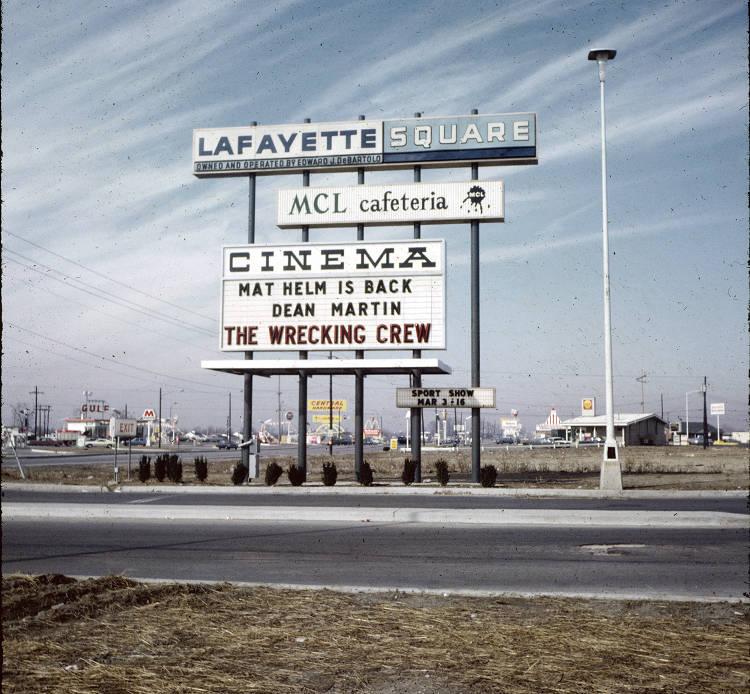
Indianapolis followed national trends with regard to the growth and development of shopping centers in the 1950s. These small shopping centers naturally followed the migration of the population out from the cities into developing suburbs. Increased suburbanization coupled with suburbanites’ increasing use of the automobile diverted the downtown retail business closer to its customer base.
In the late 1950s, six downtown stores accounted for 90 percent of department store sales in Marion County. These stores were , , , , F. W. Woolworth, and S. S. Kresge Company. By 1972, downtown sales had plummeted to 18 percent of overall Marion County department store sales.
Some of the earlier shopping centers were built specifically to hold a collection of retail stores. These strip centers consisted of rows of stores whose storefronts faced a common plaza.
One of the first examples of a strip mall came with the opening of the retail stores in the Meadows Shopping Center in December 1956. Developers initially planned for 30 stores, but more stores and a bowling alley opened in subsequent years. The largest Kroger supermarket in Indianapolis found its home at “The Meadows.” The completed shopping center celebrated its grand opening in August 1957. The venue brought downtown Indianapolis stores such as Wasson’s, Woolworth’s, and Murphy’s to the burgeoning east side suburb offering an alternative to downtown shopping.
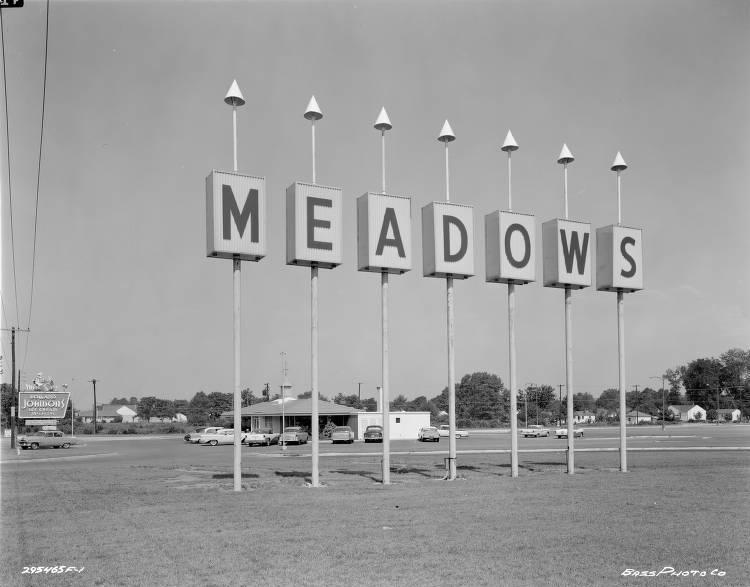
More strip malls opened in the other suburbanizing areas of Indianapolis. Eagledale Plaza Shopping Center opened on August 22, 1957, and Twin-Aire Center opened sometime in 1957.
When Eastgate Shopping Center opened on Indianapolis’ eastside, it signaled the beginning of the end for downtown department stores. The first operational stores in Eastgate Center were a Sears Catalog and Appliance store and a two-story H. P. Wasson & Company store. These opened for business on March 18, 1957. Governor Harold W. Handley attended the grand opening of the 40 stores on September 19, 1957. At that point, Eastgate became Indiana’s largest shopping center.
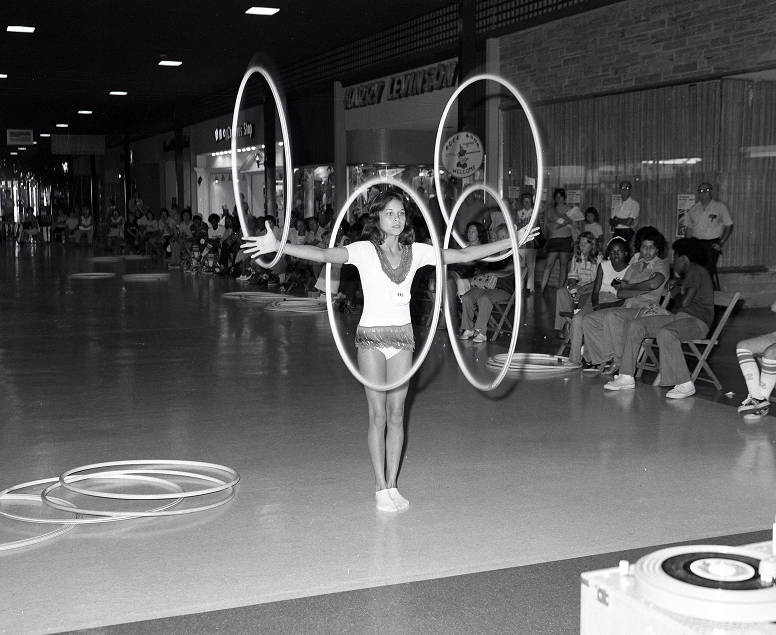
With the success of Eastgate, the trend of suburban shopping centers spread to each side of town with Glendale Shopping Center, 1959; Devington Plaza, 1959; Southern Plaza, 1961; and Greenwood Shopping Center, 1968.
The strip mall concept caught on in Indianapolis and so did the shopping mall model, which allowed shoppers to stay close to their own neighborhoods and consume goods in climate-controlled environments. The idea of going downtown to shop became a thing of the past.
Enclosed Shopping Malls
In 1968, the opening of Lafayette Square, the city’s first enclosed mall located at 3919 Lafayette Road, set a standard for future retail centers in the area. Designed to attract customers from a wide area rather than from a limited suburban quadrant, it had one million square feet of space.
Lafayette Square boasted three department stores—William H. Block Company, Sears, and J. C. Penney—and later added L. S. Ayres. The mall contained nearly 100 smaller stores, predominantly clothing shops, but had a diversity of specialty shops and services such as restaurants, a supermarket, theater, bank, bakery, and florist. This large collection of retail shops was intended to meet every shopping need in one convenient location. Other attractions included the climate-controlled interior, fountains, live tropical plants, a staff of hostesses, security patrols, ample free parking, free promotional entertainment, and easy accessibility from major streets and highways.
The success of Lafayette Square prompted its developer, the Edward J. DeBartolo Corporation of Youngstown, Ohio, to build two similar malls: Castleton Square, 6020 East 82nd Street, in 1972, and Washington Square, 10202 East Washington Street, in 1974.
Melvin Simon and Associates, a major mall developer headquartered in Indianapolis, purchased the Greenwood and the Eastgate shopping centers, enclosed them under roofs, and remodeled and expanded them to compete in size and appeal with the other major malls in the city.
Upon enclosure in 1982, Eastgate became known as Eastgate Consumer Mall. Burlington Coat Factory Warehouse moved into the Wasson’s space as the mall’s new anchor. Billed as a “value-based, off-price” mall, it essentially was an outlet mall ahead of its time.
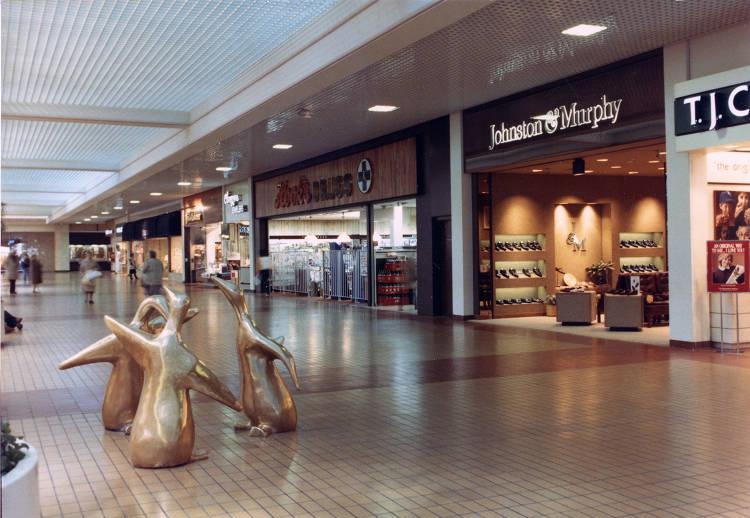
Melvin Simon and Associates enclosed and remodeled the Glendale shopping center in 1969 and expanded it in 1973. In addition to adding a roof to shelter shoppers from inclement weather, the developers converted part of an underground loading area to house more retail space.
Melvin Simon and Associates also opened the Keystone at the Crossing center in 1973, along with two adjacent shopping areas, the Bazaar and the Fashion Mall. The Fashion Mall was expanded in 1980, 1982, 1988 (in conjunction with razing the Bazaar), and again in 1993.
Satellite centers, or strip centers built adjacent to major malls, proliferated across the city in the 1980s, offering tenants low rental and access to the automobile traffic generated by the large malls. Examples of satellite centers include Castleton Shoppes, near Castleton Square Mall; Lafayette Shoppes, near Lafayette Square Mall; Washington Shoppes, near Washington Square Mall; and Greenwood Shoppes, near Greenwood Park Mall.
Revitalization of Downtown Shopping
As major developers built new malls or enclosed existing strip centers to create the type of climate-controlled retail environment shoppers desired, some Indianapolis stakeholders redirected their energy to the former downtown shopping district. As early as 1974, the Indianapolis Project Inc., the promotional arm of the city’s redevelopment programs, injected more than $2 billion in private and public funds to revitalize the central business district.
became a key element in the economic development of the city. In 1982, local developers Robert A. and Sandra Borns proposed a plan to convert the decaying Union Station into a festival marketplace. “Festival marketplaces” were part of a movement to revive downtown retail by renovating existing structures into entertainment centers that featured retailers, kiosks, restaurants, live music and performances, among many other forms of entertainment. Inspired by marketplaces found in Europe, Union Station anchored the revitalization efforts for Indianapolis’ central business district. Funding for the $60 million private-public sector restoration project came through federal grants and loans combined with financing from three banks, merchants, and the Borns.
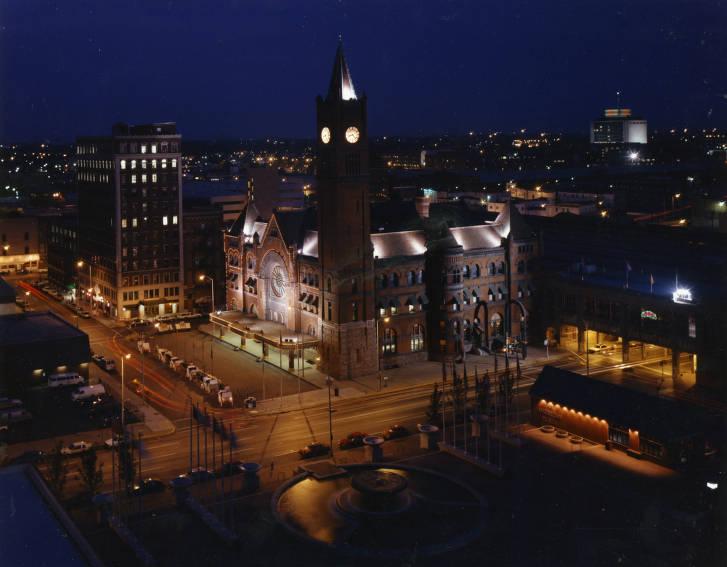
Beginning in 1984, the facility was renovated and converted from its primary function as a railroad station to a festival marketplace featuring a renovated grand hall, Crown Plaza Hotel, and a Midway Marketplace. The Indianapolis architecture firm of was responsible for the restoration of the station’s historic shed, which reopened with over 100 restaurants and shops on April 26, 1986.
As the movement to restore the downtown area to retail shopping prominence gained traction, (formerly Melvin Simon and Associates) constructed Claypool Court in 1985 on the historic site of the former . The project included restaurants and retail outlets on the lower floors and a high-rise Embassy Suites Hotel.
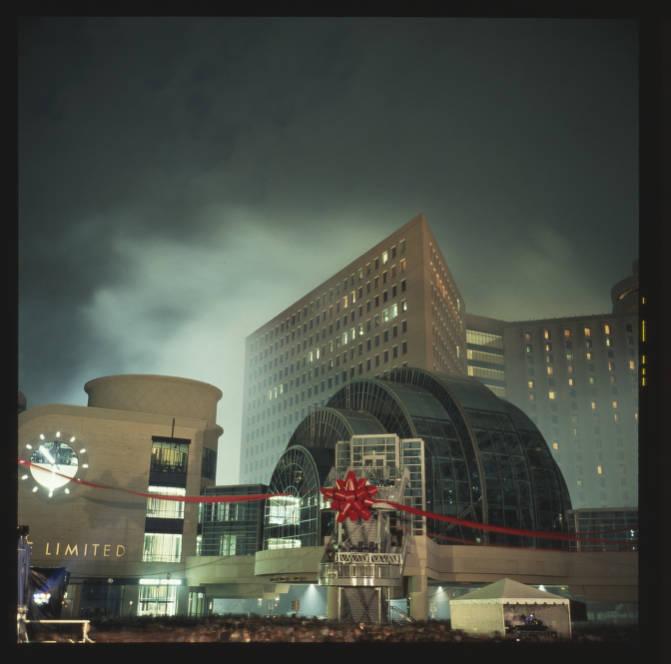
In March 1989, the demolition of many historic buildings in downtown Indianapolis marked the beginning of the construction of a major downtown shopping mall, first planned to open in 1993. From its inception, problems plagued the project. Debate over the valuation of necessary real estate on the north side of Washington Street required the relocation of the mall to the south side of the street, preservationists mourned the loss of many historic buildings, and citizens decried the gaping holes created in the downtown landscape by the demolitions. Upscale anchor tenant Saks Fifth Avenue and local favorite L. S. Ayres dropped out as anchor tenants before the end of 1990.
By 1991, the New York firm Ehrenkrantz and Eckstut Architects had replaced the original design architect. Ehrenkrantz and Eckstut redesigned the mall and included the , a space for public arts events suspended over Washington Street. The new plan and timeline for completion of the mall added financing complications to the project. The original $100 million price tag ballooned to $1 billion by June 1991 but ultimately settled at $307.5 million (not including the $12 million provided for construction of the Artsgarden). Ultimately, financing consisted of $187 million in city bonds; $75 million from 14 Indianapolis-based companies, including Lilly Retirement Fund, , , and , collectively known as Circle Centre Development Partners; and $45 million in constructions loans from three European banks.
The September 1995 opening of the Circle Centre Mall marked the culmination of Mayor ’s and Simon Property Group’s many years of planning for the downtown Indianapolis commercial resurgence. The public-private project, however, drew off most of Union Station’s retail customers, contributing to its decline. Although the marketplace concept at first had been successful, a planned pedestrian bridge between the Union Station and Circle Centre never surfaced for historic preservation reasons, and a direct underground connection was deemed not to be economically feasible. By 1997, the festival marketplace strategy for Union Station had been designated a failure. The facility’s last non-hotel and non-transportation tenant vacated the premises, and Indianapolis’ government took ownership of the facility.
While Union Station was faltering, Circle Centre Mall initially was a success. Former mayor Hudnut cited its role in spurring downtown redevelopment. It drew investment and business downtown by attracting conventions to the city.
Lifestyle Centers
Leading into the 21st century, Simon Property Group and Indianapolis-based Lauth Property Group codeveloped on 62 acres of land in . The codevelopers intended the 2004 opening of Central Indiana’s first lifestyle center to usher in a new type of open-air shopping reminiscent of the pre-World War II mainstreet shopping district. Traditional retail stores with vintage-looking facades interspersed with leisure amenities such as a central tree-lined boulevard, fountains, street furniture, and burning fire pits were meant to attract upscale consumers.
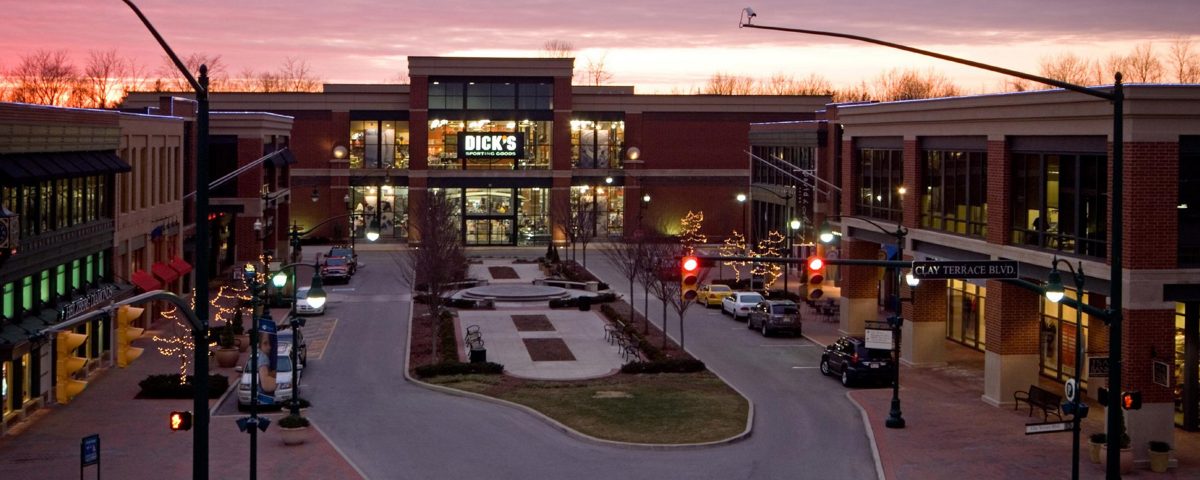
Clay Terrace served as the model for additional lifestyle centers in Central Indiana. The first opened on October 29, 2005, in , 10 miles southwest of Indianapolis in . Indianapolis-based Premier Properties opened the 550,000-square-foot Metropolis Lifestyle Center in Plainfield, with a mix of retail, restaurants, and entertainment. Memphis-based Poag Shopping Centers purchased the mall in 2014 from a court-appointed receiver after the mall’s original owner filed for bankruptcy. An $11.5 million renovation gave the lifestyle center, rebranded as The Shops at Perry Crossing, a nostalgic community feel similar to that of Clay Terrace.
Noblesville’s Hamilton Town Center opened in May 2008 to become the second lifestyle center inspired by Clay Terrace. Despite launching during the Great Recession (December 2007-June 2009), Simon Property Group’s 950,000-square-foot lifestyle center defied the slowdown in the retail sector. Part of its success came from its location in an area known for its disposable income and growth, characteristics that continue to propel forward growth for Hamilton County retail centers. Expansion of the high-end, open-air lifestyle center concept, however, stalled in 2009 with the struggling economy, increased online competition, and a crowded retail landscape.
More than a decade would pass before a novel retail development plan came to Central Indiana. The city of entered a partnership with Chicago-based MAB Capital Investments LLC in June 2021 to develop a 274-acre mixed-use concept slated to include commercial, residential, office, and recreational space. Featuring a senior living community, multi-family residences and townhomes, office space, restaurants, and various businesses and retail, Hyde Park aims at expanding on the original lifestyle center concept to something more sustainable over time. With diverse and dense housing options on-site, the updated lifestyle center model is designed to overcome the problem of lowered foot traffic during the cold winter days, which had spurred the enclosure of open-air strip malls 60 years prior and fueled the growth of climate-controlled shopping malls.
Adaptive Reuse of Malls
But shopping malls overall have faced an uncertain future in the 21st century. Upscale shopping aside, the increasing number of big-box stores such as Walmart and Target, the ease of internet shopping, and income inequality that has left less money in the hands of the middle class have impacted shopping malls negatively resulting in shuttered storefronts.
In the face of these developments, adaptive reuse of shopping malls and strip centers has gained traction. The uncontested pillars of real estate—location, location, location—are still critical, and functionally obsolescent and struggling malls are coveted spaces for adaptive reuse since, by necessity, most are located advantageously near major transportation corridors, are proximate to significant population centers, and include generous parking fields.
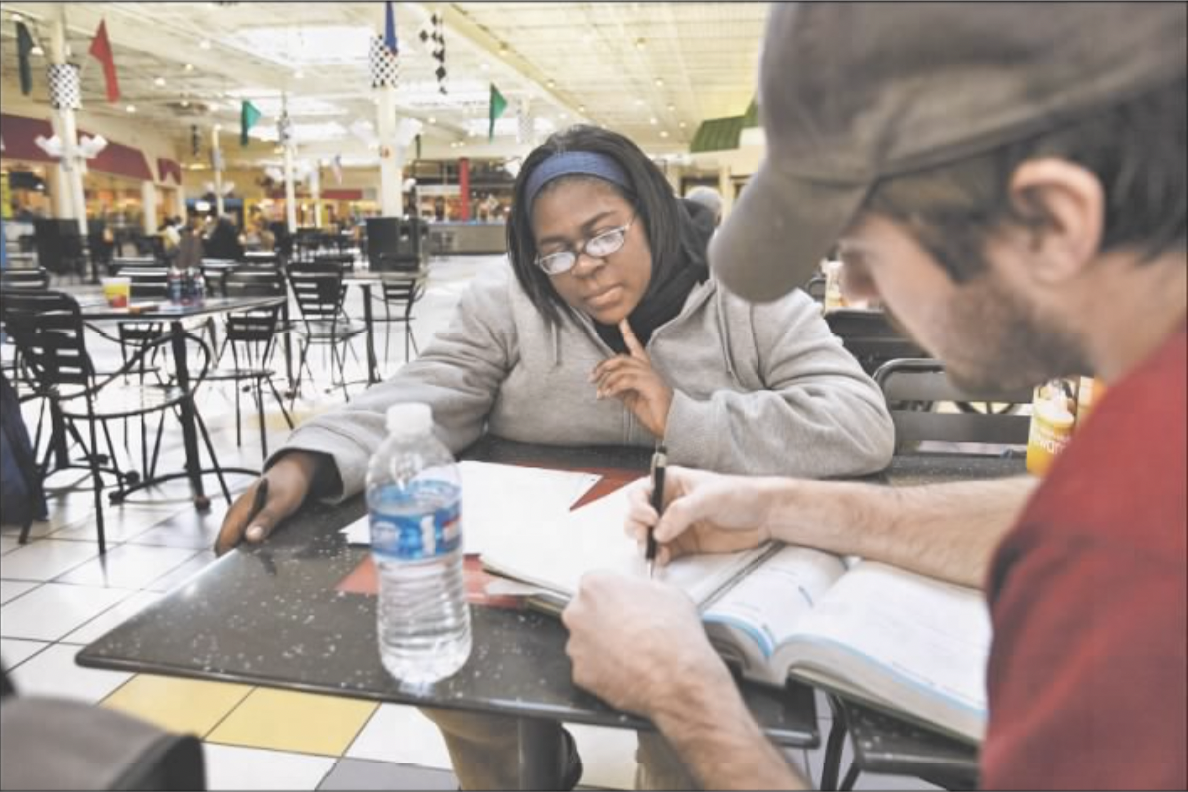
In Indianapolis, the reuse model has taken hold. Underutilized commercial space has presented an innovative solution to the problem of overcrowded and/or low-performing schools. In 1998, Simon Property Group, by then the nation’s largest mall owner and operator, along with the Simon family, created the Simon Youth Foundation (SYF) to establish relationships with public school systems in its drive to fill commercial space in its malls and elsewhere. A few years later, the became the first NBA team to partner with a public school system and the city of Indianapolis to create an educational concept. As part of the Pacers Education & Literacy Initiative, the Pacers provided corporate partnership to the Pacers Academy Middle School and High Schools. The City of Indianapolis repurposed Union Station, the former festival marketplace, making its grand hall an event center and offering rent-free space in the facility to provide a self-paced, self-directed learning environment for at-risk high school students. While the partnered with the Pacers at the Union Station location, Pike Township Schools partnered with the team at Lafayette Square Mall. Both schools opened on August 2, 2001.
In addition to providing space for the Pacers alternative school, Union Station became the home to the Mexican Consulate, Indiana’s first and only foreign consulate, in November 2002. By 2004, SYF had collaborated with IPS and the Indiana Pacers to sponsor the Union Station, IPS alternative school, renamed the Simon Youth Pacers Academy. In 2006, the students were separated to create the Simon Youth Pacers Academy Middle School at Union Station and the Simon Youth Pacers Academy High School at Lafayette Square Mall. A year later, SYF partnered with Warren Township Schools to open a second high school, Simon Youth Pacers Academy East at Washington Square Mall.
Other mall developers adopted different strategies. Prior to the Great Recession in 2007, Glendale Mall was redeveloped into an outdoor lifestyle center, though unlike the two in Hamilton County that largely attracted upscale retailers. With this renovation, Glendale included a branch of the , Staples, Stein Mart, Old Navy, Target, and an AMC Theater that served the Glendale area’s middle-class core consumer group.
Another former open-air strip center converted to an enclosed mall had a slower history of transformation. Simon Property Group sold Eastgate Consumer Mall in 2002. Slated for demolition, Alex Carroll purchased it in 2008 and repurposed the abandoned mall as a wholesale data housing center. The Indianapolis Department of Public Safety became an outside tenant of the new facility in 2011. In 2013, New Generation Power of Chicago installed a 4-megawatt solar array in the parking lot.
Circle Centre Mall began filling its space with nontraditional tenants in 2011 after anchor store Nordstrom left, precipitating the departure of additional retail tenants. Brown Mackie College became the first, leasing space on the fourth floor of the mall. Most notably, the relocated its headquarters from its longstanding home on Pennsylvania Street to the Nordstrom location in 2014.
In 2011, the moved to its own space in the neighborhood, and the Simon Youth Pacers Academy Middle School also left Union Station that same year. The closure of Simon Youth Pacers Academy at Washington Square Mall followed in 2013, and the school at Lafayette Square Mall moved to a free-standing location north of Pike High School at about the same time. Despite the withdrawal of these schools from these spaces, the concept of using commercial venues as educational spaces survived. In 2015, SYF partnered with IPS to open a Simon Youth Academy at Circle Centre Mall. In 2021, 62 students graduated from the school.
Simon Property Group planned a complete renovation of Circle Centre for 2018-2020, but the COVID-19 pandemic stymied the project. The retail real estate giant sold its share of the property at the end of 2020, leaving the remaining partners in the Circle Centre Development Company with the task of finding new redevelopment strategies. The departure of the Mexican Consulate and the Simon Youth Pacers Academy hardly affected occupancy at Union Station, which in 2021 remains 95 percent leased with the Crowne Plaza Hotel; engineering firm CHA Consulting; and Music for All, a nonprofit that advocates for school music education.
The impermanence of the shopping mall-to-school concept at Lafayette Square appears to have provided an opportunity to repurpose the mall wholesale by updating the Lafayette Square Area Plan that the City of Indianapolis first proposed in 1999. The update takes into consideration the changing market conditions and demographics of the area, which was renamed the . Instead of using Lafayette Square Mall as a medical office or other types of office space, Sojos Capital announced in November 2021 that it would turn the Lafayette Square Mall and several surrounding properties into a vibrant new neighborhood called “Window to the World.” The plan will renovate the main mall property into a mixed-use campus anchored around housing, entertainment, retail, and dining.
The 2020-2021 COVID-19 pandemic could be the final blow from which many enclosed malls will not be able to recover. The U.S. is simply over retailed by as much as 1.1 billion square feet, primarily due to overbuilding prior to the Great Recession and the rapid growth of e-commerce. The success or failure of malls also seems to match closely the economic realities of their surrounding communities. Just as many strip centers and malls have risen and fallen with the fortunes of their neighborhoods, so do shopping malls. Those malls that continue to thrive tend to be in more affluent communities. The ability of retail owners and developers to reinvent shopping malls to meet changing community needs and demands in the 21st century is expected to be a major factor in determining their success and sustainability.

Help improve this entry
Contribute information, offer corrections, suggest images.
You can also recommend new entries related to this topic.

